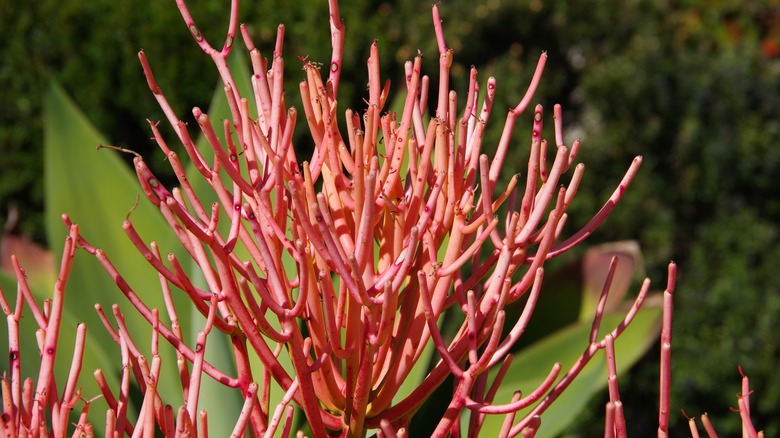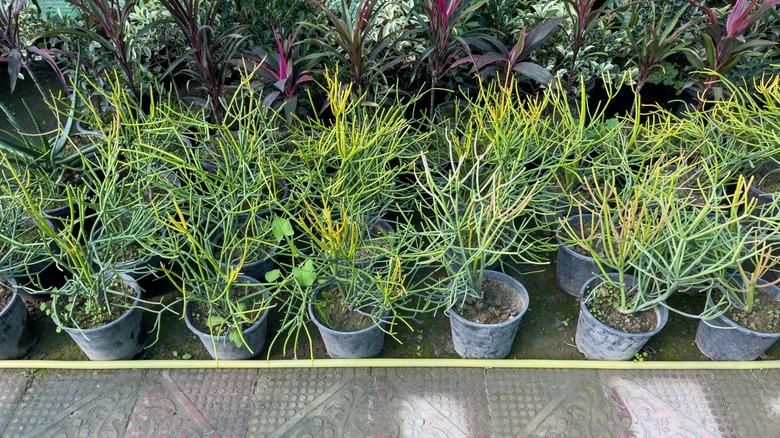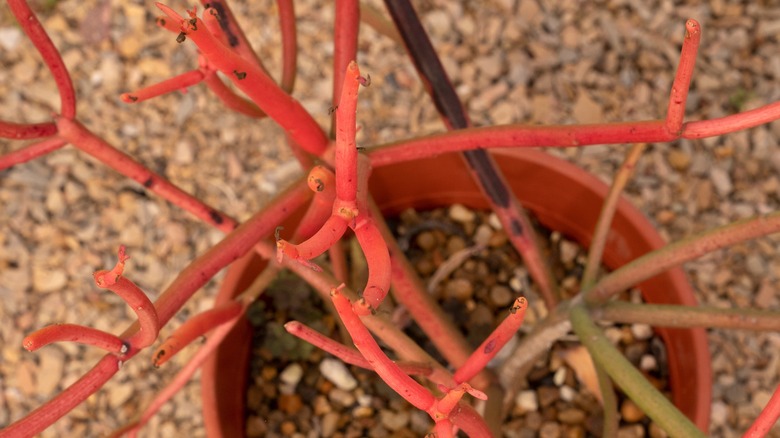The Benefits Of Planting Firestick Plants In Containers Instead Of The Ground
You've likely seen a firestick plant (Euphorbia tirucalli) in your local tropical plant store, or even outdoors if you live in USDA Hardiness Zone 11. But it may have been called by another name: this euphorbia is also commonly called Indian tree spurge, African milkbush, rubber euphorbia, petroleum plant, pencil plant, and sticks of fire. It's also frequently referred to as pencil cactus colloquially, although it's technically not in the cactus family. Whatever you call them, the appeal of firestick plants is clear: their unique, spindly branches are beautiful, often turning a bright red with enough sunlight, and like other popular low-maintenance succulents, they can thrive on neglect. Given enough space, they can grow up to 30 feet tall and 6 to 10 feet wide, developing woody trunks and primary branches.
But if a large, sturdy tree isn't what you're looking for — or even if it is — you might consider keeping your firestick plants out of the ground and in a container instead. Potting your pencil plants can help you to control their size — whether as a houseplant or shrub — but the benefits don't stop there. Using containers for your firestick plants allows you to relocate them during unsuitable weather conditions and keep them out of reach of children and pets who might be curious about the plants' toxic, latex-ridden sap. In general, moving, pruning, and caring for your pencil cactus is much simpler with container gardening methods.
Benefits of potting firestick plants
There are plenty of benefits to container gardening, but when it comes to firestick plants, there are a few extra reasons to reach for a container. While it's easy to pot up a container plant when it outgrows its planter, it's harder to predict just how much space your pencil plant might take up in an outdoor garden, and harder still to uproot it if it reaches maturity. Firestick plants can also be propagated by cuttings, so any fallen branches of a firestick plant might root into new baby firestick plants, which will be much easier to manage or share in a pot than all over the ground in your yard. Perhaps most important to your firestick's health is your climate: in most areas of the U.S., firestick plants are not winter hardy, and will need to be moved indoors when temperatures drop in order to survive. Planting them in containers that you can relocate as temperatures change will ensure that your plants remain happy and healthy.
Planting your firesticks in containers means greater control over their moisture levels in rainy seasons, too, as container plants can easily be moved to a sheltered porch or patio area. Since euphorbias are succulents, they are drought tolerant and prefer to dry out between waterings. Test to see if your potted pencil plant needs more water by feeling the top inch of soil for dryness, a variable that's harder to manage for a plant rooted in the ground.
Caring for your potted firestick plant
Care for a firestick plant will partially depend on your location. Potted firestick plants can be moved outdoors in tropical or semitropical environments, including parts of California and southern Florida, if temperatures do not exceed 75 degrees Fahrenheit or drop below 50 degrees Fahrenheit. If your area doesn't meet these growing conditions year-round, be sure to move your plants indoors when the seasons change. Regardless of your plant's location, be sure that the container you house your firestick in has good drainage and is filled with very well-draining soil: firestick plants require a drying period between waterings in their summer growing season and little to no water at all in the winter, so overwatering is easy if you're not watchful.
Since firestick plants are slow-growing, they won't need frequent potting up or pruning, but when it comes time to propagate or trim down your firestick plant, exercise caution. When cut or otherwise broken, firestick plants will leak a toxic sap that is irritating to the skin and eyes, so gloves are required for any handling of the plant where accidental exposure to its sap may occur. Protective eyewear and sterile, sharp pruning shears to ensure minimum wounding will also make this process safer and easier.


